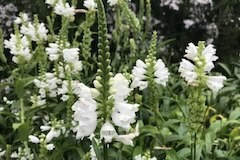- Out-of-Stock



Moisture fertile clay soil loving perennial, combining well with upright spikey varieties like veronicastrum, lysimachia etc.
Moisture fertile clay soil loving perennial, combining well with upright spikey varieties like veronicastrum, lysimachia etc.
Data sheet
One of the first plants I grew from cutting; quick growing and floriferous in a short space of time. In summer it requires complete cutting to the ground like an oriental poppy, and will resprout in autumn when there is sufficient moisture. Easy and quick to fill in spaces; pink flowers.
Improved strain from Germany with multiple stems and darker blue flowers than the species. Good for cutting and drying.
Old fashioned "catmint", mostly used as a border or edging in cottage gardens. Soft blue flowers, trim lightly in mid summer for a repeat flower in autumn.
Paprika red yarrow, fades to attractive dusky red as flowers age. Easy drought and frost hardy perennial, medium height.
Tall semi evergreen perennial for dry gardens. Usually late winter flowering with tall stems of clustered lime green flowers. Good for winter structure amongst herbaceous plants.
Late summer flowering variety with fine petalled soft blue flowers, clumping and non invasive. Combine with deschampsia, echinacea, sedums and eupatorium.
Prolific cascading groundcover phlox with rich pink flowers in early summer; great plant amongst rocks, bedding.
A tall cultivar flowering later than the species with pale blue semi-double flowers.
Low growing rivale type with a long flowering period, good for path edging or foreground beds, these do best in heavier soils with some fertility, but in good soil are drought hardy and will take some summer heat.
Lovely species with wine red bells on tall stems. Often the bracts are a silvery grey which contrast nicely with the darker bells. Needs fertile conditions
A vigorous semi double windflower for part or full shade, spreads well in mass planting or individually in shady garden corners or under deciduous shrubs. Flowers late summer.
A bushy plant with many branched stems topped with dark yellow black centered cone flowers. The foliage is a dark glossy green similar in appearance to heliopsis and echinaceas. Flowers from mid-summer into autumn.
A striking biennial for shade, forming strong mounds of good foliage and normally flowers in second or third year once the plant has acheived maturity, after which it will self seed. This is the rarely offered white form, the common form is pink.
We originally raised this from a batch of wild seed collected for us by some friends in Prebbleton New Zealand. We have reproduced these from cuttings, as special charachteristic is better vigour than the usual insignis seedlings. Leaves are olive green with a hint of grey, branching bushy spectacular shrub with white flowers for a sunny alkaline well...
Delicious plum purple colour, mass plant in autumn with iris, delphiniums and Canterbury Bells for spring flowering.
Resembles Euphorbia martinii in flowering, having a reddish brown spot within the green bract. Closer in habit to Euphorbia wulfennii, this a more dependable garden plant, proving itself as long lived in a variety of dry situations.

Moisture fertile clay soil loving perennial, combining well with upright spikey varieties like veronicastrum, lysimachia etc.